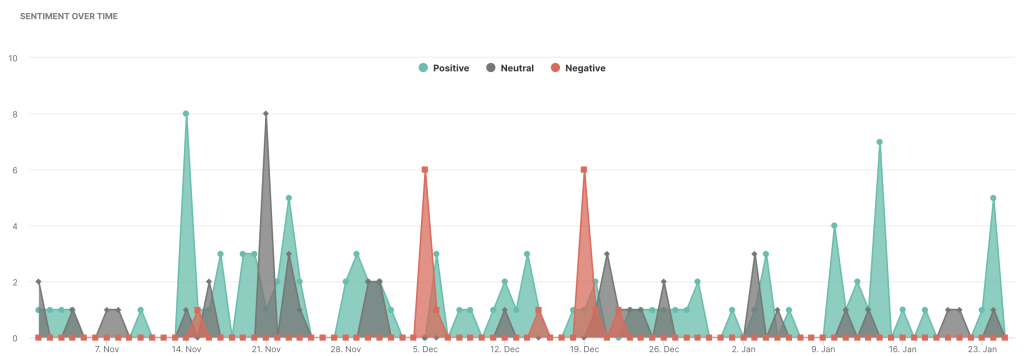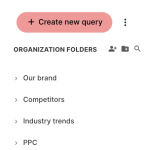There are so many elements that you need to manage while running a political campaign.
Public perception, candidates with different personalities, unexpected events, sneaky opponents, and the list goes on. Stakes are high and your every move should be strategic and well thought out.
? Read Media Monitoring: The Ultimate Guide
It was never simple running a campaign, but the internet and social media only made it more complex. You need to be vigilant and keep track of everything. Also, you need to be smart in handling your money and the people who work for you.
Why would you put ten interns to track web and social media platforms all day when a tool can do that for you? These interns are more useful in the field, campaigning, and establishing relationships with potential voters by sharing their experiences and thoughts on why they should vote for your candidate.
Media monitoring informs you on the most important parts of the campaign efforts – public, opponents, media, and the elections and provides you with actionable political campaign analytics.
Engage with the Public During a Political Campaign
First, we’ll start with the public aka voters – your most important audience.
There is no point in running a political campaign without listening to what your voters want and need.
People tend to express their opinions more freely when hiding behind a nickname, so chances are you might find valuable information you can use to improve your program.
Even polls are not as reliable these days because people often lie to pollsters.
And then there are Millennials and Gen Z.
Both groups are getting most, if not all, information from the internet and social media. It is also known that they are now making a large part of the eligible voter base and that they are not very keen to go vote on election day.
With an informed and strong political social media strategy that’s based on media monitoring, the opportunity to reach younger voters could’ve been seized.
Read Perfecting Your Business Pitch: Best Practices for Writing and Delivery
Track the public perception of your candidate
People will almost 100% of the time voice their opinion on social media, especially if the opinion is negative. Social media became what the public forums and bars were in the past.
If you want to know what people think and feel, go on social media. If you want to know how your candidate is performing, go on social media. If you want to do that and save time and money, use media monitoring. Finally, if you want people to notice you, make sure your social media political campaign is on point.

Engage with (undecided) voters
Undecided voters are the ones who give the most headaches to candidates. There is a constant battle to win them over and make sure that they will vote for you on election day.
By using media monitoring you can track what the voters want, what problems they are facing, what issues they are passionate about, etc. That way you can detect the main concerns and incorporate them in the campaign messaging. Also, you can respond to their questions and concerns and build a strong relationship with them that way.
Find influencers
Finding the right influencers can help you reach more voters and spread your message faster. As the English writer, Nick Hornby said when comparing the Oscars and political campaigns:
“You have to have the right candidates, and the people in Hollywood know what they are.”
That can often be a Sisyphean task if you’re an unknown candidate and you don’t have the right tools for it. In our reports, you get a list of the top 10 influencers mentioning your candidate and that way you can decide which ones you want to contact to help you with the campaign.
Read Find Influencers With Social Listening Tools
Track Your Opponent(s)
While running a campaign you have to keep track of your opponents’ every move. Not in a weird way, though.
Use media monitoring.
By running a Competitor analysis, you will stay one step ahead. The worst thing you can do is to underestimate your opponent and be too confident that voters are going to vote for you. Don’t let the hubris get the best of you.

Track your opponents’ performance
See how the opponent’s message is resonating with voters or check what public activities the opposition campaign is organizing/attending.
You can detect what is missing in their messaging and communication with the voters and fill in the gaps to win the voters over. Also, you can learn from your opponent’s mistakes by monitoring the crisis they’re going through.
Opponents’ attacks
You can track opponents’ attacks in real-time whether they’re using social media, news outlets, or their rallies. Also, you can track whether or not those attacks are resonating with the public. If you notice that the attacks are making a difference and damaging your campaign, you’ll have enough time to react to calm the situation down.
That way you won’t have to sweat the small stuff and focus on things that matter. This will also give you a great chance for a counter-attack.
Read Improve Your Political Campaign with Media Monitoring
Follow the News about Your Political Campaign
You can scream “FAKE NEWS!” at the articles all you want after every single media outlet has already published them and everybody is talking about it.
Once the avalanche starts, it is hard to stop it.
Especially with people constantly forwarding articles without checking the source. The strategy “let’s wait, it’ll go away by itself” is not the smartest one.
Today, the number of information people daily receive equals what people hundreds of years ago received in a year or more. That’s why you should be the one to point out the information that is beneficial for your client and fight the false ones.
Unfortunately, fake news spreads quickly, and sometimes it can have very serious consequences. Just remember the 2016 Presidental Elections and the “Pizzagate” scandal.
By using media monitoring you can react quickly to refute the falsehoods.
A lot of times your opponents tend to spread fake news to bury your political campaign efforts. The news media outlets, unfortunately, often jump on the bandwagon without checking whether the information is true. The thing is that “fake news” existed long before Trump, he just made it popular.
Media monitoring can help you detect the false information that has already gone viral and confront the opponents and voters with truth in time.

During the Election Day…
Have you ever heard of elections where everything went smoothly?
No? I thought so.
In Croatia, we often joke that even the dead can vote in our elections (it happened folks!). So, if you want to be notified in real-time whether some fishy things going on in voting places (or during the election day in general) what better and quickest way to do so is there than media monitoring?
For example, in the 2018 US midterm elections, there were many irregularities in the voting places and people were profusely tweeting about it and that’s how the information became known to the public. That is the perfect example of why media monitoring is so important. You don’t have to depend on news media or scroll through social media like a maniac to know what’s going on. Let the tool do the work for you.
Also, it’s important to set up your keywords right (e.g. election irregularities, voting place, voting fraud, etc.) depending on your interests and potential problems so the tool can show you better results.
Keeping Track of Political Campaign Analytics
Keeping track of your political campaign analytics is important, and media monitoring can help you do just that.
But where to start, you may wonder? Just keep reading.
Here are some helpful tips.
Setting up relevant queries
First, you need to set up queries.
Types of queries you should track are your :
- candidate’s name,
- your party name, slogan,
- the names of opponents,
- the names of opposition parties,
- key figures,
- key journalists,
- public discussions, etc.
You can also organize them in folders for a better overview.
For example, queries about your client and party can go under one folder, opponents and opposition parties in another, and so on…

That way your queries are going to be organized and you’ll be able to use them effectively while making reports.
After you’ve set up queries you’ll get a list of mentions on your feed for every query. You can then filter and remove them, make reports, analyze them manually, etc.
Set up your own queries and start monitoring your online presence!
Virality
On the right side of your feed, you can find various filtering options. Among them, there’s an option to sort your mentions by time, reach and virality.
Virality is a metric that tells you how successful an article is in comparison with all the other articles from that same website.
Virality is the filtering option that is especially useful when it comes to detecting where did the fake news actually come from. With this knowledge, you’ll be able to react fast and stop it from spreading by addressing the situation.
Read How to Track Reputation after a Political Campaign with Media Monitoring
Creating media monitoring reports for the campaign
Now that you’ve sorted out your mentions, you can go ahead and make reports. There are four types of reports you can choose from.
- First, you have a basic one that will give show you the number of mentions and impressions, sources, sentiment analysis, etc. It’s a great first step to get an insight into how your campaign is resonating with voters.
- Then, there are the advanced additional insights. In this report, you can get detailed information about influencers, sentiment, sources, and others.
- The third one is a competitive analysis in which you can compare how your candidate is performing against the other candidates.
There’s also a custom reports option with which you can customize existing reports by adding/removing charts, customizing parameters, and rearranging charts order.
Read 5 PR Report Templates and Hacks to Instantly Prove the Value of Your Work

Campaign sentiment analysis
To get an insight into how the people are perceiving your candidate, use our sentiment analysis.
There are three types – automatic, effective, and manual.
The automatic one is not 100% accurate since the computer can’t detect sarcasm, for example. But it is good for a basic overview of your candidate or your opponent’s online presence.
The next one is the manual analysis, which allows you to go through the mentions and classify them as you perceive them – positive, negative, or neutral. Because of that, this one is the most accurate out of the three.
- Pro tip: you can set up Automated actions to assign sentiment for you instead of doing it manually.
The effective analysis is the combination of the previous two and is good for your daily reports.
Read Top 5 Examples of Sentiment Analysis
To Summarize
All things considered, the added value that media monitoring brings to your overall political campaign analytics is extremely important.
It can save you money, it can save your reputation, it can give you information that is vital for making good strategic moves…
There’s no way of escaping social media these days, so why make your work harder when it doesn’t have to be. Also, at the end of the elections, you’ll have valuable data that you can use to see what were your strengths and weaknesses. That way you’ll make even better decisions next time around!
If you’d like to be sure that your campaign is headed in the right direction, book a demo call and let our experts explain how Determ can help you along the way.



